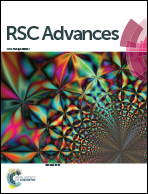Enhancement of As(v) adsorption from aqueous solution by a magnetic chitosan/biochar composite
Abstract
In this study, a magnetic chitosan/biochar composite (MCB) was prepared successfully, and characterized by SEM, TEM, VSM, XRD, FTIR, XPS, and zeta-potential to obtain its physical and chemical properties. The influence of different sorption parameters such as pH, contact time, initial As(V) concentration, and temperature on As(V) removal were studied thoroughly in order to optimize the reaction conditions. The results showed that the MCB adsorbed more As(V) (11.961 mg g−1) than pristine biochar (3.681 mg g−1). In addition, the adsorption behavior could be well described by a pseudo-second-order and Langmuir model. Thermodynamic parameters revealed that the sorption reaction was a spontaneous and endothermic process. The adsorbed MCB could be effectively regenerated by 1.0 mol L−1 NaOH, and the adsorption capacity decreased from 11.823 to 8.078 mg g−1 in five cycles. In conclusion, MCB could be used as an efficient adsorbent for environment purification and conveniently separated from aqueous solution after adsorption.



 Please wait while we load your content...
Please wait while we load your content...